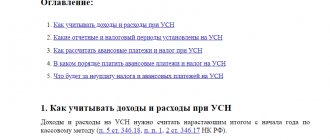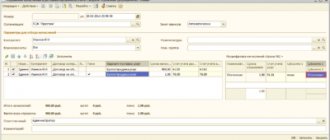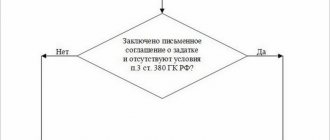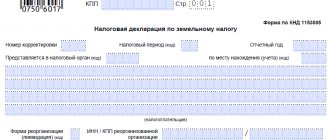When using the “income minus expenses” accounting scheme, the organization must take into account the condition of applying the simplified tax system, which concerns the right to reflect expenses in accounting only after the actual fulfillment of obligations to the second party - the sale of goods (works, services). Accounting for offset transactions Enterprises using the simplified tax system are required to keep accounting of business transactions. Entities are allowed to apply a minimum number of accounts per work plan. In accounting, standard entries required by law are made. When registering offsets, accounts 76, 60, 62 are used. The transaction is recorded by posting: Dt 60 (76) Kt 62 (76). An example of netting: The enterprise Rassvet LLC maintains accounting using the simplified tax system with the object “income minus expenses”. Rassvet LLC shipped goods to Master LLC in the amount of 250,500 rubles.
How to arrange a netting when settling income minus expenses
Important
The notification should indicate the amount of claims to be counted, the numbers and dates of documents indicating the occurrence of mutual debt. The risk of adverse consequences associated with carrying out a unilateral offset and expressed in the other party’s rejection of the subject of the offset can be reduced through the preliminary preparation and signing by the parties of a settlement reconciliation act.
Preliminary preparation of reconciliation reports is also recommended when conducting bilateral and multilateral offsets. An offset carried out by agreement of two or more participants is formalized by an act of offset of mutual claims, signed by all participants in the offset. Attention
If mutual claims are different in size, only the claim that is smaller in size is fully repaid. The obligation for which a larger claim is presented is partially preserved.
The procedure for netting under the usn “income”
Definitions: Offsetting under the simplified tax system for income is the repayment of counter homogeneous claims. In other words, organizations that use counteraction effectively cancel equivalent obligations under existing agreements.
Offsetting can be applied to supply agreements, contracts, etc. Homogeneous claims mean obligations that arose on the basis of different agreements, but with the same method of repayment.
In other words, if the parties have different valid agreements that require payment for goods or services in money, then such requirements are recognized as homogeneous.
Results
Mutual obligations to each other in business are not uncommon. Mutual offset allows organizations to pay each other, while saving time and money on bank commissions. Accounting for offset transactions is the same for all tax regimes. For a company using simplified taxation system (STS) income, offset means the receipt of revenue, which must be taken into account for tax purposes.
You can find more complete information on the topic in ConsultantPlus. Full and free access to the system for 2 days.
Income and expenses when netting on the simplified tax system
For organizations participating in non-monetary transactions operating under the simplified tax system, the occurrence of income is confirmed by the fact of receipt of funds to the current account, and not by the signing of an act drawn up between the parties to the agreement, but the company reflects the expense in KUDiR after shipment and offset between the parties to the agreement. For example, having received a signed certificate of completion of work, the executing company includes the amount in expenses (in 1C, how to reflect income on a certificate of completion of work, look for information in open sources of information). KUDiR is maintained in a single copy, even if the entrepreneur has several trading branches.
Records of transactions are reflected in KUDiR on the basis of information from the primary report papers, which are stored by the entrepreneur until the end of the period when it is no longer possible to carry out (for example, from 2008 to 2018) the transfer of losses from previous years.
How to work on income 6%
The Tax Code of the Russian Federation recognizes the date of receipt of income from persons applying the simplified tax system as the day of receipt of funds into bank accounts and (or) cash desks, receipt of other property (work, services) and (or) property rights, as well as repayment of debt (payment) to the taxpayer in another way (cash method). In the letter dated 04/07.
2014 N 03-11-11/15467 The Ministry of Finance of Russia indicated that when an organization applying the simplified tax system receives goods on account of services performed and offsets mutual claims, income from the sale of services performed is taken into account as part of income when determining the object of taxation on the date of receipt of goods. The date of receipt of goods in this case will be the date of offset of mutual claims. That is, for the purposes of Art.
Offsetting in case of registration of legal entities: sample
When registering mutual settlements, it is worth taking into account the peculiarities of such transactions under the simplified tax system. The book of accounting for income and expenses (an example of offset, assignment and compensation, issued in KUDir, can be found in open sources) reflects the corresponding transactions based on the fact of income received and expenses incurred.
For example, let’s say offset – for rent. Using the simplified tax system, income minus expenses of an enterprise often formalizes such a transaction. Offsetting (as reflected in KUDir, see below) is a common method of non-monetary settlements. Under the simplified tax system, an organization's income is recognized on the day funds are credited to the current account or deposited in the enterprise's cash register, or the acquisition of new property or services as repayment of the counterparty's debt.
Therefore, in tax accounting, the offset is considered payment under the agreement. Income and expenses under the simplified tax system are taken into account on the date of termination of the obligations of the participant in the transaction.
Conducting mutual offsets between enterprises using the simplified tax system
Companies, if their accounting features, asset size, and headcount meet the requirements, often use the simplified tax system when conducting business. Features of the application of a special taxation regime:
- Possibility to choose the accounting scheme “income” or “income minus expenses”.
- Maintaining simplified document flow and accounting.
- Application of the cash method of accounting for income and expenses.
- Inclusion of expenses on a limited list.
When keeping records of an enterprise on the simplified tax system, it uses primary documents that are the basis for making an entry in KUDiR, which also includes data on mutual offsets. When carrying out the procedure, it is necessary to take into account the taxable object chosen by the enterprise.
Offsetting under the simplified tax system for legal entities: sample
The offset can be unilateral, bilateral or multilateral.
Depending on its type, the documents used to formalize it differ. Unilateral set-off As has already been said, a statement from one party is sufficient for set-off.
But in order to avoid disputes with the counterparty, it is advisable to carry out a reconciliation before sending an application for offset. The act of reconciliation of mutual settlements will confirm the amounts of debts. This document will be especially important in the case when part of the contracts has already been paid (the remaining debt amounts will be recorded in the act). Before submitting an application for offset, you must make sure that the primary documents are available.
The most common cases of mutual settlements under the simplified tax system
Next, we will consider the main issues related to the implementation of mutual offsets:
- Does offset apply to the income of the enterprise?
- What does contraction have to do with VAT?
- How to display the repayment of counter homogeneous claims in 1C.
The question that the repayment of accounts receivable is income was discussed above (see the subheading “Reflection in accounting ...”).
Question No. 1. Should VAT be reflected in the netting act if the supplier with whom the netting is being carried out operates on a common taxation system?
Yes, the VAT amount must be reflected in the offset act. If offset is not made for the entire amount of the debt to the supplier, VAT must be calculated in proportion to the amount of the debt.
Question No. 2. Is it possible to draw up an act of mutual settlement in which there will be 4 participants?
Yes, multilateral reconciliation acts are allowed. In this case, it is advisable to confirm counter-debts between all participants by acts of reconciliation of mutual settlements (if any).
Question No. 3. Is it necessary to indicate the exact date of the test when conducting a test unilaterally?
The application for offset may indicate that the date of offset will be considered the date of receipt of the application by the counterparty.
Settlement under “simplified”
Other courts also note that to terminate an obligation by offsetting a similar counterclaim, a statement from one of the parties is sufficient. The law does not require the consent of the other party to the offset made. However, it is important that she receives the application for offset (reg. FAS PO dated January 28, 2007 No. A55-6395/2007). If the company does not have evidence of delivery of the statement of offset to the counterparty, then it will still be in debt, penalties and interest will continue to accrue for the use of other people’s money (post.
FAS ZSO dated 02.05.2006 No. F04-1722/2006(21923-A81-10)). Bilateral or multilateral offset Bilateral offset can be formalized by an act, agreement or protocol for the offset of mutual claims.
The name of the document (act, agreement or protocol) does not matter. The main thing is that such a document contains all the necessary details provided for by law (Article 9 of Law No. 129-FZ).
Offsets and their reflection in accounting on the usn
For posting, we enter the act of offset in 1C 8.3, for example, so that the completion of the transaction is reflected in the book of income and expenses. Managers of organizations should carefully consider the procedures for mutual settlements, because the Law provides for some restrictions on such transactions. A ban on concluding such a procedure is sometimes specified in the transaction agreement! Tax authorities study mutual settlement agreements very carefully, because an incorrectly executed such agreement can be recognized by the tax inspectorate as an exchange agreement, which implies completely different tax and accounting records.
Assignment An assignment agreement is essentially an assignment of claims. When concluding such an agreement, one party transfers the rights of claim to a third party, for example, a factoring company, more often at a loss to itself, that is, the amount of income may be less than the amount of expenses for the transaction.
Should the operation of debt adjustment be included in kudir: netting?
In other words, the debtor repays financial obligations to the second party to the contract without the use of funds. Such calculations include:
- mutual settlement;
- cession;
- compensation
Within the framework of one obligation, it is allowed to combine methods of repaying debt under an agreement or supplement them with payments from a current account. For example, the debtor pays off part of the amount in cash, and the rest - under a mutual settlement agreement. Non-monetary settlements are made only after the subject of the transaction agreement has been fulfilled. It is impossible, for example, to set off the cost of a service that will be provided only next month. Organizations using the simplified system, as is known, keep tax records on the basis of the Book of Income and Expenses (KUDiR), making entries in this tax register on transactions made.
On the basis of what document does the accountant write off the debt when conducting unilateral mutual offset? When carrying out a unilateral mutual offset operation, a universal document is used - an accounting certificate. The document describes the basis for the offset, the forms used (application and others), confirmation of the fact of delivery of the notice to the partner, and the rationale for the date of repayment of the debt.
Question No. 5. How can a netting operation be carried out if one of the parties has expired the statute of limitations for the shipment? The law prohibits offsetting transactions that have expired. In this case, it is possible to restore the period of financial claims by transferring it from the moment of shipment to the date when the subject learned about the existing debt. Rate the quality of the article.
FAQ
Next, we will consider the main issues related to the implementation of mutual offsets:
- Does offset apply to the income of the enterprise?
- What does contraction have to do with VAT?
- How to display the repayment of counter homogeneous claims in 1C.
Is offset income under the simplified tax system?
The question that the repayment of accounts receivable is income was discussed above (see the subheading “Reflection in accounting ...”). ,
The profit received is recognized by taxpayers on the day the act is signed (Article 346.17 of the Tax Code of the Russian Federation).
In this case, the repayment of the buyer's receivables is considered the seller's income, regardless of which taxation method he chose.
As a result, in the book of income and expenses, it is necessary to make an appropriate display of the received amount of debt that was paid by the counterparty.
Whereas the buyer, who is a single tax payer at a rate of 15%, recognizes expenses in the form of closed accounts payable.
Relationship with VAT
When filling out the netting act, it is imperative to indicate the total amount of debt of the parties to the agreement, including VAT. You also need to indicate the amount of debt that is canceled by offsetting with the allocated VAT.
Video: accounting for costs of legal systems under the simplified tax system
To make it clearer how accounting entries are made in this case, it is necessary to consider a specific example.
Enterprise “X”, on the basis of an agreement dated 04/20/2014, shipped products to IP Sviridov K.L. in accordance with the invoice dated 05/01/2014. The total amount for the goods including VAT (30 thousand rubles) was 330 thousand rubles.
In turn, individual entrepreneur K.L. Sviridov, on the basis of an agreement dated February 20, 2014, conducted marketing research for the X enterprise.
The work completion certificate was signed by the parties on June 1, 2014. The total amount for services including VAT (21.6 thousand rubles) amounted to 141.6 thousand rubles.
On the day of signing the act, IP Sviridov K.L. issued an invoice to enterprise “X”. In accordance with the terms of the existing agreements, the parties signed an act of offset of mutual claims dated July 20, 2014, in the amount of 141.6 thousand rubles.
The entrepreneur paid the difference in the amount of debt under the agreement dated April 20, 2014 3 days after signing the act.
The amount of payment including VAT (17,127 rubles) amounted to 188.4 thousand rubles. Transactions are displayed in the accounting of enterprise “X” as follows.
| Dt 62 Kt 90 (330 thousand rubles) | Goods shipped, including VAT |
| Dt 90 Kt 68 (30 thousand rubles) | The VAT amount for the above products is displayed |
| Dt 26 Kt 60 (120 thousand rubles) | Market research services received are displayed |
| Dt 19 Kt 60 (RUB 21.6 thousand) | VAT on the above services is displayed |
| Dt 60 Kt 62 (141.6 thousand rubles) | Settlement has been made |
| Dt 68 Kt 19 (21.6 thousand rubles) | VAT on services provided is deductible |
Reflection when working with 1C
When using the 1C Accounting 8 program, the taxpayer’s income and expenses are taken into account on the basis of standard accounting documents.
The formation of a ledger of income and expenses according to the simplified tax system occurs in the “Reports” menu – “Income ledger…”. Here the results of its completion are checked. A special 1C accounting mechanism has been introduced for this operation.
This tool is quite useful for taxpayers who use “Income minus expenses” as a tax object. Recording of offsets also occurs in the ledger of expenses and income.
Photo: interface in 1C program
To display the organization’s costs, you need to open the corresponding menu:
Photo: interface in 1C program
Offsetting under a simplified taxation system
According to Art. 410 of the Civil Code of the Russian Federation, the obligation is terminated in whole or in part by offsetting a counterclaim of the same type, the due date of which has come or the due date of which is not specified or determined by the moment of demand. For offset, a statement from one party is sufficient.
Offsetting mutual claims is a common practice in any accounting department. However, not every accountant knows the answer to the question of how to correctly arrange offsets. However, it is the correctness of registration and accounting of this operation that determines whether the risk of claims from inspection authorities and partners against this organization is possible. This is especially true for organizations that use a simplified taxation system, since the repayment of mutual claims from such organizations is directly related to taxation.
Is it possible to reduce the tax rate at a rate of 6 percent for insurance premiums?
Income and expenses may be recognized in another way. And mutual offset is precisely that other way. Thus, on the date of offset of mutual claims, the organization has both income and expense.
Important
Settlement and “simplified” are partially compatible “Simplified” also consider their income and expenses using the cash method. But as we said, it is different from the cash method for income taxes. We quote the law. “The date of receipt of income is the day of receipt of funds into bank accounts and (or) the cash desk, receipt of other property (work, services) and (or) property rights (cash method). Expenses of taxpayers are recognized as expenses after their actual payment" (Art.
346.17 of the Tax Code of the Russian Federation). Judge for yourself. In contrast to the variety of grounds for recognizing income and expenses under the usual regime, in the “simplified” regime their list is somewhat smaller.
Basic rules for offsetting mutual claims
- Organizations must have counter-claims to each other, i.e. at least two different agreements are concluded between them, in one of which the organization is a debtor, and in the other - a creditor.
- Counterclaims must be homogeneous.
What does “homogeneity” mean? Obligations that are related to the execution of different contracts, but involve the same method of repayment, can be considered homogeneous. Let’s assume that repayment is initially expected under two different contracts in cash, which means that the requirements are homogeneous. If the obligations of organizations under one agreement are expressed in natural units, and under another - in monetary terms, then these obligations are not recognized as homogeneous. Consequently, it is impossible to carry out offsets under such agreements.
This conclusion is confirmed by judicial practice. For example , paragraph 7 of the Appendix to the Information Letter of the Presidium of the Supreme Arbitration Court of the Russian Federation dated December 29, 2001 N 65 states that the legislation does not insist that the requirement for offset arise from the same obligation or from obligations of the same type.
- Settlement is possible subject to the deadline for fulfilling the counterclaim or provided that this period is not specified in the contract.
- Testing is not possible in the following cases:
one of the parties to the offset has not reached the deadline for fulfilling its obligations (Article 410 of the Civil Code of the Russian Federation);
a bankruptcy case has been initiated against one of the parties to the offset (clause 14 of the Information Letter of the Presidium of the Supreme Arbitration Court of the Russian Federation No. 65);
the limitation period has expired for the obligations (even if at least one of the parties to the contract declares this);
obligations are associated with compensation for harm caused to life or health, with the collection of alimony, and lifelong maintenance of citizens.
- The offset of mutual claims, like any business transaction, must be documented (Clause 1, Article 9 of the Federal Law of November 21, 1996 N 129-FZ). Civil legislation does not impose any special requirements for registration of offsets. At the same time, in Art. 410 of the Civil Code of the Russian Federation states that in order to carry out offset, a statement from one of the parties is sufficient.
Tax accounting during mutual offset
For posting, we enter the act of offset in 1C 8.3, for example, so that the completion of the transaction is reflected in the book of income and expenses. Managers of organizations should carefully consider the procedures for mutual settlements, because the Law provides for some restrictions on such transactions. A ban on concluding such a procedure is sometimes specified in the transaction agreement!
Assignment An assignment agreement is essentially an assignment of claims. When concluding such an agreement, one party transfers the rights of claim to a third party, for example, a factoring company, more often at a loss to itself, that is, the amount of income may be less than the amount of expenses for the transaction.
In other words, the debtor repays financial obligations to the second party to the contract without the use of funds. Such calculations include:
- mutual settlement;
- cession;
- compensation
Within the framework of one obligation, it is allowed to combine methods of repaying debt under an agreement or supplement them with payments from a current account. For example, the debtor pays off part of the amount in cash, and the rest - under a mutual settlement agreement. Non-monetary settlements are made only after the subject of the transaction agreement has been fulfilled.
On the basis of what document does the accountant write off the debt when conducting unilateral mutual offset? When carrying out a unilateral mutual offset operation, a universal document is used - an accounting certificate. The document describes the basis for the offset, the forms used (application and others), confirmation of the fact of delivery of the notice to the partner, and the rationale for the date of repayment of the debt.
We invite you to read: Acceptance by the heir of part of the inheritance means
Question No. 5. How can a netting operation be carried out if one of the parties has expired the statute of limitations for the shipment? The law prohibits offsetting transactions that have expired. In this case, it is possible to restore the period of financial claims by transferring it from the moment of shipment to the date when the subject learned about the existing debt. Rate the quality of the article.
- Organizations must have counter-claims to each other, i.e. at least two different agreements are concluded between them, in one of which the organization is a debtor, and in the other - a creditor.
- Counterclaims must be homogeneous.
What does “homogeneity” mean? Obligations that are related to the execution of different contracts, but involve the same method of repayment, can be considered homogeneous. Let’s assume that repayment is initially expected under two different contracts in cash, which means that the requirements are homogeneous.
This conclusion is confirmed by judicial practice. For example, paragraph 7 of the Appendix to the Information Letter of the Presidium of the Supreme Arbitration Court of the Russian Federation dated December 29, 2001 N 65 states that the legislation does not insist that the requirement for offset arise from the same obligation or from obligations of the same type.
- Settlement is possible subject to the deadline for fulfilling the counterclaim or provided that this period is not specified in the contract.
- Testing is not possible in the following cases:
one of the parties to the offset has not reached the deadline for fulfilling its obligations (Article 410 of the Civil Code of the Russian Federation);
a bankruptcy case has been initiated against one of the parties to the offset (clause 14 of the Information Letter of the Presidium of the Supreme Arbitration Court of the Russian Federation No. 65);
the limitation period has expired for the obligations (even if at least one of the parties to the contract declares this);
obligations are associated with compensation for harm caused to life or health, with the collection of alimony, and lifelong maintenance of citizens.
- The offset of mutual claims, like any business transaction, must be documented (Clause 1, Article 9 of the Federal Law of November 21, 1996 N 129-FZ). Civil legislation does not impose any special requirements for registration of offsets. At the same time, in Art. 410 of the Civil Code of the Russian Federation states that in order to carry out offset, a statement from one of the parties is sufficient.
An organization can notify its counterparty in writing about the offset (Article 410 of the Civil Code of the Russian Federation). For this, it is sufficient to have mutual monetary debt. The document notifying about the offset in this case can be either an application, a letter, or a notification (notice). It is better to send an application for offset to the counterparty by registered mail with notification.
If, when a dispute arises, the organization does not prove that the counterparty received this statement, the offset of the counter-obligation may be declared invalid (clause 4 of Information Letter of the Supreme Arbitration Court of the Russian Federation No. 65, Resolution of the FAS Volga District dated January 28, 2008 in case No. A55-6395/2007, FAS Central District dated 08/30/2006 in case No. A23-3149/03G-10-121, Federal Antimonopoly Service of the West Siberian District dated 05/02/2006 N F04-1722/2006(21923-A81-10)).
Without consequences, a unilateral offset can be carried out only when there is absolute confidence in the amounts of mutual debt. Let’s say that if an act of reconciliation of mutual settlements is signed, then in this case the organization has every right to carry out a unilateral offset by sending a statement to the counterparty, even if such an offset is not included in the plans of the counterparty.
The organization can also set the date for the unilateral offset itself. To do this, you must indicate in the application a specific date from which the obligations of the parties are considered fulfilled; the offset is recognized as having taken place from this date. If the date is not indicated in the application, then the offset is considered to have taken place from the day the counterparty received the application.
It is possible to carry out both full and partial offset of mutual claims. Full set-off can be carried out if the counterclaims are identical in amount. Quite often, a different situation arises when the requirements are different and offset can be carried out for the amount of the smallest debt (partial offset).
Example. has a debt to pay for goods supplied under a sales contract in the amount of 100,000 rubles. “B” has a counter-debt to “A” to pay for work in the amount of 60,000 rubles. According to the statement, the parties decided to offset mutual claims on April 5, 2011.
After the offset, the obligation to remains in the amount of 40,000 rubles. Liability to the amount of 60,000 rubles. repaid in full.
In accounting, the offset of mutual claims is reflected in subaccounts opened for each counterparty to accounts 60 “Settlements with suppliers and contractors”, 62 “Settlements with buyers and customers”, 76 “Settlements with various debtors and creditors”.
D-t 60 (76), K-t 62 (76) - reflects the termination of the counter-obligation to pay for goods (work, services) by offsetting mutual claims.
In accordance with clause
Enterprises using the simplified tax system are required to keep accounting of business transactions. Entities are allowed to apply a minimum number of accounts per work plan. In accounting, standard entries required by law are made. When registering offsets, accounts 76, 60, 62 are used. The transaction is recorded by posting: Dt 60 (76) Kt 62 (76).
The enterprise Rassvet LLC maintains accounting using the simplified tax system with the object “income minus expenses”. Rassvet LLC shipped goods to Master LLC in the amount of 250,500 rubles. In the same month, Master LLC carried out repair work for Rassvet LLC in the amount of 30,500 rubles. The companies agreed to set off the amount of accounts payable that was the same for both organizations. The following entries are made in the accounting of Rassvet LLC:
- The following mutual claims were offset: Dt 60 Kt 62 in the amount of 30,500 rubles;
- Revenue from the sale of goods is reflected: Dt 62 Kt 90/1 in the amount of 30,500 rubles;
- The cost of shipped products is taken into account: Dt 90/2 Kt 41 in the amount of 30,500 rubles;
- The work paid for by the act was taken into account: Dt 20 Kt 60 in the amount of 30,500 rubles.
Enterprises using a simplified system maintain tax accounting by making an entry in the tax register - the Book of Income and Expenses. Based on the information reflected in the book, the tax base is determined and a single tax is calculated. When executing mutual netting transactions, there are several key points to consider.
| Condition for tax accounting | Description |
| Documentation of the operation | Entries in KUDiR are made on the basis of primary accounting documents |
| Moment of revenue determination | Income arises at the time of drawing up, signing the act or other date specified in the document accompanying the offset |
| The moment of determining expenses | The right to record expenses arises after shipment and mutual offset. |
How to correctly offset mutual claims Carrying out unilateral offset
An organization can notify its counterparty in writing about the offset (Article 410 of the Civil Code of the Russian Federation). For this, it is sufficient to have mutual monetary debt. The document notifying about the offset in this case can be either an application, a letter, or a notification (notice). It is better to send an application for offset to the counterparty by registered mail with notification. If, when a dispute arises, the organization does not prove that the counterparty received this statement, the offset of the counter-obligation may be declared invalid (clause 4 of Information Letter of the Supreme Arbitration Court of the Russian Federation No. 65, Resolution of the FAS Volga District dated January 28, 2008 in case No. A55-6395/2007, FAS Central District dated 08/30/2006 in case No. A23-3149/03G-10-121, Federal Antimonopoly Service of the West Siberian District dated 05/02/2006 N F04-1722/2006(21923-A81-10)).
Without consequences, a unilateral offset can be carried out only when there is absolute confidence in the amounts of mutual debt. Let’s say that if an act of reconciliation of mutual settlements is signed, then in this case the organization has every right to carry out a unilateral offset by sending a statement to the counterparty, even if such an offset is not included in the plans of the counterparty.
The organization can also set the date for the unilateral offset itself. To do this, you must indicate in the application a specific date from which the obligations of the parties are considered fulfilled; the offset is recognized as having taken place from this date. If the date is not indicated in the application, then the offset is considered to have taken place from the day the counterparty received the application.
Bilateral netting agreement
A less conflicting option is to conduct a bilateral offset of mutual claims, for which it is only necessary to draw up a bilateral offset document, which is usually an act of offset. However, this document can be called differently, for example, an agreement or protocol. The netting act is not a unified accounting document, therefore it can be drawn up in any form in compliance with the requirements for primary accounting documents (clauses 1, 2, article 9 of Law No. 129-FZ, Resolution of the Federal Antimonopoly Service of the North-Western District dated May 21, 2007 in case No. A05-12882/2006-25).
In the act of offset, it is necessary to clearly indicate all the circumstances of the offset: the amounts accepted for offset; details of documents confirming debts (contracts, invoices, acts of acceptance of work (services), invoices), as well as the debt repayment period established by the contract, so that there is no doubt about the validity of the offset. Failure to provide such information may result in disputes that may subject the organization to contractual sanctions.
There are examples of court decisions that confirm this position (for example, Determination of the Supreme Arbitration Court of the Russian Federation dated July 2, 2007 N 4790/07, Resolution of the Federal Antimonopoly Service of the Volga-Vyatka District dated September 26, 2007 in case N A11-13478/2006-K1-11/612).
In addition, incorrect registration of offsets may result in tax penalties.
Partial offset of mutual claims
It is possible to carry out both full and partial offset of mutual claims. Full set-off can be carried out if the counterclaims are identical in amount. Quite often, a different situation arises when the requirements are different and offset can be carried out for the amount of the smallest debt (partial offset). In this case, the obligation for which the largest claim is presented is partially preserved, and the obligation for which the smaller claim is presented is terminated in full.
Example. has a debt to pay for goods supplied under a sales contract in the amount of 100,000 rubles. “B” has a counter-debt to “A” to pay for work in the amount of 60,000 rubles. According to the statement, the parties decided to offset mutual claims on April 5, 2011.
After the offset, the obligation to remains in the amount of 40,000 rubles. Liability to the amount of 60,000 rubles. repaid in full.
Multilateral offset
The right of organizations to carry out multilateral offset of obligations is provided for by the provisions of Art. 421 of the Civil Code of the Russian Federation, which states that the parties can enter into an agreement, both provided for and not provided for by law or other legal acts. At the same time, general provisions on the contract apply to agreements concluded by more than two parties, unless this contradicts the multilateral nature of such agreements (clause 4 of Article 420 of the Civil Code of the Russian Federation). Typically, with multilateral offsets, an agreement is concluded on mutual settlements. Such an agreement is not a unified accounting document, so it can be drawn up in any form in compliance with the requirements for primary accounting documents (clauses 1, 2, article 9 of Law No. 129-FZ).
When conducting a multilateral offset, one basic rule should be taken into account: in case of unequal debts, the offset is carried out for the amount of the least of them.
Agreement on mutual settlements
represented by _________, acting on the basis of the charter, hereinafter referred to as “Party 1”, represented by _________, acting on the basis of the charter, hereinafter referred to as “Party 2”, and represented by __________, acting on the basis of the charter, hereinafter referred to as “Party 3” ", have concluded this Agreement on mutual settlements in the following order:
- Party 1 terminates the monetary obligations of Party 3 in the amount of ___________, which arose on the basis of the agreement ___________ in the amount of ___________.
- Party 2 terminates the monetary obligations of Party 1 in the amount of ___________, which arose on the basis of the agreement ___________ in the amount of ___________.
- Party 3 terminates the monetary obligations of Party 2 in the amount of ___________, which arose on the basis of the agreement ___________ in the amount of ___________.
- This Agreement is drawn up in three copies having equal legal force, one for each of the Parties.
- The Agreement comes into force from the moment of signing and is valid until the Parties fully fulfill their obligations.
- The Agreement can be terminated only by mutual consent of the Parties.
Unilateral refusal to fulfill obligations assumed under this Agreement is not permitted.
- Disputes arising during the execution of the Agreement are subject to consideration in arbitration court.
- Signatures of the parties.
Reflection of offset of mutual claims in accounting and tax accounting
In accounting, the offset of mutual claims is reflected in subaccounts opened for each counterparty to accounts 60 “Settlements with suppliers and contractors”, 62 “Settlements with buyers and customers”, 76 “Settlements with various debtors and creditors”.
The offset of mutual claims is reflected in the following entry:
D-t 60 (76), K-t 62 (76) - reflects the termination of the counter-obligation to pay for goods (work, services) by offsetting mutual claims.
In accordance with clause
A complete guide to the tax rate 6% - 2021
The date of receipt of income is recognized as the day of receipt of funds into bank accounts and (or) the cash desk, receipt of other property (work, services) and (or) property rights, as well as repayment of debt to the taxpayer in another way (cash method). Expenses of taxpayers are recognized as expenses after their actual payment.
For the purposes of this chapter, payment for goods (work, services and (or) property rights) is recognized as the termination of the counter-obligation of the taxpayer - the purchaser of the specified goods (work, services) and property rights to the seller, which is directly related to the supply of these goods (performance of work, provision of services , transfer of property rights)” (clauses 2, 3, Art.
Settlement in the usn
1, 2 tbsp. 346.17 of the Tax Code of the Russian Federation, the date of occurrence of income (expense) when applying the simplified taxation system is the date of actual payment for goods shipped (work performed, services rendered), including through termination of the counter-obligation. Therefore, if, as a result of offsetting mutual claims, receivables are repaid, then the seller organization applying the simplified taxation system must recognize income (clause 1 of article 346.15, clause 1 of article 346.17 of the Tax Code of the Russian Federation). The recognition of income does not depend on what object of taxation the organization applies - “income” or “income minus expenses”.
In practice, income received as a result of offsetting mutual claims is reflected in the Book of Income and Expenses on the date of repayment of the obligation (in any form). The basis for making entries in the Book of Income and Expenses is the act of offsetting mutual claims (either an agreement or an application).
For purchasing organizations that pay a single tax on the difference between income and expenses, offset is the basis for recognizing expenses in the form of repaid accounts payable (clause 1 of article 346.16, clauses 1, 2 of article 346.17 of the Tax Code of the Russian Federation). Accounts payable for certain types of expenses must be recognized taking into account the features characteristic of the items being written off, for example, when including the cost of goods purchased for further sale as expenses.
To summarize the above, it should be noted that a series of offsets for large amounts may attract the close attention of the tax authorities, mainly due to the fact that in the case of offset of mutual claims there is no real settlement for the goods (work, services) received. However, the courts support the taxpayer, so it is not advisable to completely refuse offsets.
D. Kornilov
Executive Director
LLC "Auditorskaya"
Loan agreement for crediting services when to recognize income
> > > Tax-tax August 27, 2021 20874 Offsetting under the simplified tax system “income” often raises questions among accountants.
How to reflect offset in documents, what is the procedure for carrying it out, what to do when the amounts of mutual obligations are disproportionate? We will answer these questions in the article.
Subscribe to our accounting channel Yandex.Zen The main conditions for offsets are contained in the Civil Code of the Russian Federation.
These include: The presence of counterclaims.
Offsetting is carried out in the presence of at least 2 agreements, so that both organizations are simultaneously a debtor and a creditor. It is impossible to offset if only one company has debt.
Uniformity of requirements. This refers to a uniform method of repaying debt, for example in cash, despite the fact that
Peculiarities of taxation under loan agreements under the simplified taxation system (STS)
“Taxes” (newspaper), 2009, N 7 Relations arising when concluding a loan agreement are regulated by paragraph 1 of Chapter. 42 of the Civil Code of the Russian Federation. According to it, the lender transfers money or other things into the ownership of the borrower, and the borrower undertakes to return the same amount or an equal number of the same things (clause
Otherwise, the transaction will be considered void, since it already represents a purchase and sale. For a transaction concluded between legal entities or between a legal entity and an individual, written documentation is required (Article 161 of the Civil Code of the Russian Federation)
Reflection of a loan under the simplified tax system (USN) income minus expenses (nuances)
> > > Tax-tax February 02, 2021 26673 Subscribe to our accounting channel Yandex.Zen A loan under the simplified tax system, income minus expenses is reflected in accounting according to generally established rules.
Let's consider these rules in relation to the simplified tax system. Neither the funds received as borrowed nor the funds issued are considered either income or expenses of the taxpayer working on the simplified tax system.
Accordingly, the return of these funds will not be regarded as either income or expense.
Regarding income, this conclusion follows from the content of Art. 346.15 of the Tax Code of the Russian Federation, referring to Art. 251 of the Tax Code of the Russian Federation, in which sub. 10 p.
1 tbsp. 346.15, paragraph 1 of Art. 248, sub. 6 tbsp. 250 Tax Code of the Russian Federation)
Offsetting under the simplified tax system “income”
The basic principles of offsetting mutual claims (offset) are defined in the Civil Code of the Russian Federation (Civil Code of the Russian Federation) in Article 410.
The obligation may be terminated by offset.
Fully or partially. The rules of offset do not depend on the taxation system and are determined equally for organizations of all forms of ownership.
Under the simplified taxation system (hereinafter referred to as the simplified taxation system), when carrying out offsets, special attention must be paid to determining the date of offset, because under the simplified taxation system, income is determined both by the direct receipt of funds and by repaying customers’ debts in other ways (clause.
How to arrange offset under the simplified tax system of income minus expenses
Organizations using the 15% tax rate are required to keep strict records of their operations, in particular their expenses.
Therefore, there is a need to understand what 1c 8 2 is and how to correctly document netting of income for legal entities under the simplified tax system. Taxpayers who are both a debtor and a credit to each other can use the following options for mutual settlement:
- Transfer money in accordance with the terms of the agreement.
- To conclude .
Offsetting is often very convenient for counterparties, if you do not take into account the mistakes that participants in such transactions sometimes make. One of these errors is the deadline that is set for the fulfillment of contractual obligations.
By law, offset can only be applied to those obligations whose terms have already expired.
If such a period is not established by agreement, then it is determined on the basis of the requirement set by the counterparty ().
Offsetting income under the simplified tax system is the repayment of counter homogeneous claims.
The organization applying the tax system on income issues a loan
Search pattern: All word forms Fuzzy search | | R.
According to the provisions of the Civil Code, the same rules apply to the activities of individual entrepreneurs as to the activities of legal entities (Article 23).
Therefore, loan agreements with the participation of entrepreneurs must be drawn up in simple written form.
The reimbursable loan agreement must specify the amount, procedure and timing of interest payment.
Will offset of mutual claims be income in case of registration?
// 04/17/2019 733 Views And most importantly, there is no recognition of debt repayment in any other way. Does this mean that offset cannot be equated to payment?
There are three points of view on this matter. The first is based on a literal reading of Art. 346.17 Tax Code of the Russian Federation. But it is unprofitable for the taxpayer, since only income can be taken into account, but expenses will disappear.
After all, there is one basis for their accounting - actual payment. Unpaid expenses cannot be taken into account.
Is a loan considered income under the simplified tax system?
Loans
The economic situation in Russia is gradually stabilizing after another crisis. Small and medium-sized businesses are also gradually moving towards development, while the majority of their representatives prefer to choose a simplified taxation system, where the income of an organization or individual entrepreneur is used for tax calculations.
But not all receipts to the cash register or to the current account are considered income; for example, loans are not.
Loan repayment under the simplified tax system “Income minus expenses”
Copyright: Lori's photobank Concluding loan agreements between legal entities and entrepreneurs, regardless of the working taxation system, is a common practice when conducting business activities.
How is the issuance and repayment of a loan taken into account? How to record interest received or paid?
Let us analyze the features of reflecting such transactions in simplified accounting, including interest-free loan agreements. According to paragraph 1 of Art. 807 of the Civil Code, a loan agreement implies the transfer by the lender to the borrower of money or property united by generic characteristics.
The signing of the agreement is accompanied by the designation of the terms of the transaction, including the amount and terms of payment of interest (clause.
Source: https://advleks.ru/dogovor-zajma-pri-usn-zachet-uslugami-kogda-priznat-dohod-39744/







